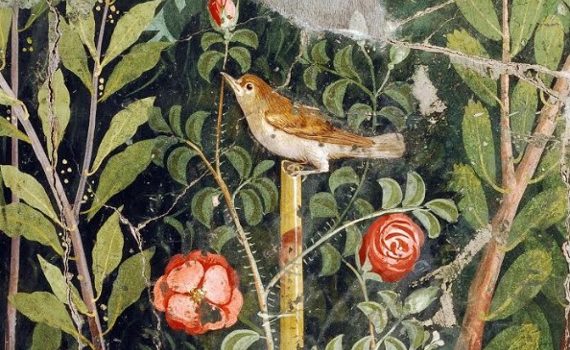Pompeii is an unlimited source of beauty and knowledge, even with regard to its plant life. Roses, the finest flowers of all time, already existed in the ancient city of Pompeii and had many uses. It was used as decoration in adorning the walls, as a food ingredient, for health and well-being products, and for cosmetics. Recently, The Ancient Rose of Pompeii has been studied as part of a research project carried out by the Archaeological Park of Pompeii (Laboratory of Applied Research), the Department of Agriculture of the University of Naples Federico II (Luigi Frusciante Professor of Genetics, and Gaetano Di Pasquale Research professor of Archaeobotany) and the association The Ancient Rose of Pompeii, which has contributed to broadening the scientific knowledge of this species, and provided information about the historical and naturalistic context of the Pompeiian and Vesuvian area.
On Wednesday 6th June 2018, at 5pm, in the garden of Villa Silvana in Boscoreale (Naples) the results of the research on the Ancient Rose of Pompeii were presented.
The research aimed at re-creating a rose with the most common genotype/phenotype in Pompeii and in the Campania region during the Roman period. It was based on archaeo-botanical investigations on ancient species grown in the Pompeii area as well as on an accurate genic and comparative analysis of the varieties and species of roses found and preserved in the Botanical gardens, the monumental cemeteries in Campania, and the ancient Italian herbaria.
The project was promoted and funded by the association The Ancient Rose of Pompeii, which also made available the rose garden of Villa Silvana in Boscoreale to grow the young rose plants. The Association, with the authorisation of the Archaeological Park of Pompeii (Dr. Michele Borgongino), is also responsible for planting the ancient roses in the gardens of some Pompeii domus, including the House of the Faun, the House of Loreio Tiburtino, and the House of the Perfumer.
For the event, the speeches were delivered by Prof. Massimo Osanna Director General of the Archaeological Park of Pompeii, Prof. Matteo Lorito Director of the Department of Agricultre, as well as the research authors Prof. Luigi Frusciante Professor of Agricultural Genetics, and Gaetano Di Pasquale Research Professor of Botany Applied to Archaeology.
Also in attendance were:
Maurizio Di Stefano, President Emeritus of Icomos, UNESCO Consultancy Office
Gianfranco Nappi, Manager of the Strategic Projects of the ‘City of Science’ in Naples
Giuseppe Marrazzo, Coordinator of the tourist Districts in the Campania Region
Pietro Amitrano, Mayor of Pompeii
Vincenzo Ascione, Mayor of Torre Annunziata
Giuseppe Balzano, Mayor of Boscoreale
Pietro Carotenuto, Mayor of Boscotrecase
Raffaele De Luca, Mayor of Trecase
Francesco Ranieri, Mayor of Terzigno
Laura Del Verme, Archaeologist and MODERATOR of the convention
After the speeches, the Amici del ‘700 Napoletano will perform a classical concert (with music by Pergolesi, Bach, Mozart and classic Neapolitan composers).
This convention is organised as part of the 6th Festival of the Rose, by now a regular event in Villa Silvana.
Rose growers in ancient Pompeii used techniques nearly as refined as the current agronomic ones. Even the perfumers from Pompeii had become sophisticated experts in the production of rose essences and perfumes. In Campania, especially in the areas of Pompeii, Paestum, and Capua, the products of rose growing and manufacturing were destined for a larger market beyond the Italian peninsula, and had become a renowned activity on the shores of the Mediterranean Sea.
In private houses, rose gardens were increasingly more important for ornamental use in the classic Pompeii gardens, as proven by many archaeological findings (e.g. in the House of the Vettii) and by paintings discovered in the Vesuvian area.
The Campania area exercised its leadership in rose growing and in the production of rose-based products for some centuries. Some analyses of the materials available have shown that actually there wasn’t just one rose species in Campania and in Pompeii, but rather a group of plants including spontaneous species and hybrids. However, the most common variety was the double-flowered remontant rose, which was also depicted in many paintings found in the archaeological sites of the Campania region. It is also known that what is nowadays called the Pompeii rose used to bloom twice a year and was red in colour.

THE ANCIENT ROSE OF POMPEII
Study project carried out by the Archaeological Park of Pompeii and the Agricultural Department of the University Federico II of Naples.
Presentation of the research results
VILLA SILVANA – 6th JUNE AT 5pm
(Via Nicola de Prisco 15, Boscoreale)

